#Textile Science
Explore tagged Tumblr posts
Text
My coworker asked me why no one has invented an athletic textile that is sweat-wicking but also odour-resistant and I said it exists and it’s merino wool 😭😭😭 and she said “bUt IsN’t WoOl ItChY? 🥺” The athletic wear companies have everyone believing that synthetic fabrics are the only appropriate athletic wear. But it is actually plastic and stinky!!! Touch wool please. If you think polyester spandex is more breathable/less hot than a light merino knit you are being fooled. Also most leggings or whatever from popular companies are terribly over-priced for what they are (plastic extruded as filaments) and you can find merino leggings or tops for around the same price as some of the higher end athletic brands.
233 notes
·
View notes
Note
Hey! I’m hoping you might have a suggestion for fabrics; I’m looking for a thick cotton to make a petticoat style skirt (like those oldschool ones made of cotton with pintucks and insertion lace). I want it thick enough that the white skirt isn’t see through and it stays stiff enough to provide volume if I use it as an underskirt, but not so thick/rough it’s uncomfortable or that I can’t gather it to be frilly. There’s so many words out there- duck? Broadcloth? Canvas? Twill? I’m not sure how to describe what I’m looking for in a Google search. All I know is I definitely don’t want quilting cotton. ‘Burberry’ (which I see a lot of brands use) just turns up plaids a la the high fashion brand. Any help would be appreciated! Thank you so much!
Anyone who is interested in burbery in the lolita context should talk to @babelglyph aka burberryglyph. The short version is that burbery is a lightweight cotton twill used in a lot of old school pieces, and B.Glyph knows where to get it, as well as can provide info about why they know that the fabric they recommend is true burbery twill, as well as why it's called burbery. I remember that they know all of this but can't remember the actual answer to any of it.
As for other fabrics you mentioned: All duck is canvas but not all canvas is duck. Duck is a plain weave and other canvasses can be a twill weave of some kind. Either way, the heavier yarn and overall thick construction is what makes canvas canvas. Fun fact, "duck tape" predated the term "duct tape" and referred to tape made of duck canvas. Broadcloth is usually interchangeably with quilt cotton, though "quilt cotton" is generally a more specific term. Broadcloth can be pretty much any fiber but quilt cotton is expected to be cotton. Some people think that broadcloth has to be a single color. Twill is a weave structure, so the words that predate it are important. "stretch twill" is going to be different from "suiting twill" or "heavyweight wool twill." If you want to see a twill weave structure, generally the most accessible example of a twill structure is denim. Look at some blue jeans and you can see how there's that slanting pattern caused by the blue threads passing over 2-3 white threads before going under a white thread? That's a twill weave structure. (You then have to have it be cotton and have the two color setup to be proper denim. Technically black jeans aren't denim, they're just twill, but no one wants to get into that fight with me.)
If you're looking for cotton fabrics that aren't quilt cotton, but tend to be in that sort of lighter weight area, I'd look for:
Cotton sateen: This is cotton fibers woven in a satin weave. This has a really subtle luster and will drape better than quilt cotton,
or
Cotton poplin: poplin has what's called an unbalanced plain weave, so the threads are woven in the same pattern as quilting cotton, but where in quilting cotton they are the same thickness vertically and horizontally, they're different thicknesses vertical vs horizontal in poplin. This means that it hangs better, and also that it has a different drape depending on if you're using lengthwise grain or crosswise grain. Poplin is used for shirting a lot.
If you need to get thicker, you will probably want to look for lightweight twill. I'm trying to not get too into textile science, which is hard because i LOVE textile science. So stick with me for a second:
The "higher quality" a fabric generally feels, in quotes there because quality is subjective, but through history we have associated finely spun yarns with a higher quality. Thinner yarns are harder to make, and you need to use more of them to make the same size fabric as you'd make with thicker yarn. Thinner yarn has to be structurally better constructed to take the force of being woven into fabric, versus a thicker yarn. So, when we want something that feels like quality, we look for fabrics spun with a thinner yarn. This is why expensive sheets are measured in thread count: more threads per inch is a better quality sheet.
However, the problem comes when you want a thicker fabric made of thinner yarns. If you've ever had a potholder loom, you understand a plain weave: a yarn goes over one yarn, under the next, over the next, and so on. Thinner threads in a plain weave will make a thinner fabric.
However, if you start using other weave patterns, you start changing fabric properties. In a twill weave, a thread will go over two or more other threads before going under another thread. One of the side effects of this is that it's possible to fit more threads into the same space than you could fit in a plain weave, meaning that you can make a thicker fabric with thinner yarns going into the construction process.
And this means that, if you're judging a fabric thickness by weight, like you know how many ounces a yard of fabric is, a twill fabric will be made of finer yarns than a canvas fabric of the same weight.
In addition to being "higher quality", we like thinner yarns in garment construction because they're more flexible, so they make the fabric hang more like a garment and less like a canvas sack.
As a final note, when you say "provide volume as an underskirt", a twill skirt with pintucks and insertion will have some volume, but if you're doing a lolita fashion look, you'll also need petticoats under that. Some fashion styles, that added volume will be enough, but in lolita fashion, if you can get the hem of your skirt to be 10" away from your legs in all direction, you're probably approaching the correct level of poof.
(But for what it's worth, if you're trying to add some more volume on a cotton underskirt that's not for lolita fashion, pintucks will make the same skirt have more volume. Creating that rigid-ish line that goes in the direction opposite of what the skirt would naturally want to fold, especially if you make several of those lines in a close spacing, will hold the skirt out and make it have more lift. Just a fun fact there. If you want to get as much volume as possible out of this, you will want to use many small pintucks, as well as the stiffest insertion that you can find. Skirts want to be small and make lots of soft vertical folds, so applying horizontal decoration that makes that folding harder to do will add volume).
I don't know how much of that was answering the ask and how much was just Pink Loves Textile Science 2023(tm)
51 notes
·
View notes
Text
Learning Process no. 1.2: Extracting lanolin from sheep wool
I'm trying to different processes for extracting lanolin
Cold prewash: I've washed it 4 times while it has soaked for a few hours about 5.
"The wool grease is continuously removed during this washing process by centrifugal separators, which concentrate it into a wax-like substance melting at approximately 38°C" - Sengupta, Amit; Behera (2014). "Comprehensive view on chemistry, manufacturing & applications of lanolin extracted from wool pretreatment,also used in vitamins" (PDF). American Journal of Engineering Research (AJER).
That means the cold wash may still have the lanolin oil
I possibly have to investigate how to do some centrifugal separation?
Boiled: I would prefer not to use this method as i understand from my research that the wool will not be useable after having it boiled. "Wool felt melts between 105 and 110F" - p. 50. the Big Book of Handspinning by Alden Amos
The water needs to boil for a few hours.
I'm reading from different sources especially this thread on permies.com
https://permies.com/t/65837/extract-lanolin-wool#2624426
And watched different videos on YouTube:
Extracting Lanolin from Sheep's Wool, Edwardian Farm
https://www.youtube.com/watch?v=d2pEIsyWD-Y
Lanolin extraction from Sheep's wool DIY : My learning Process, homemade from scratch
https://www.youtube.com/watch?v=xoH3Cv5AS4A&t=635s
If you have some knowledge to share, please do! It will be much appreciated
#Learning Process#Lanolin Extraction#Sheep Wool#Cold Prewash#Centrifugal Separation#Wool Processing#DIY Skincare#Natural Fibers#Sustainable Living#Wool Crafts#Handmade Textiles#Crafting Journey#Lanolin Research#Textile Science#Wool Grease#Lanolin DIY#Permaculture#Fiber Arts#Natural Oils#YouTube Resources#Wool Care#KnittersOfTumblr
7 notes
·
View notes
Text
I love how when I do fashion predictions for college I'm bringing up 1920s bell bottoms and pre-colonial african hair styles, but when fashion tiktok does trend predictions they're like "so... for spring we'll have florals :))))" like what
2 notes
·
View notes
Text





𝐃𝐢𝐬𝐜𝐨𝐯𝐞𝐫 𝐭𝐡𝐞 𝐛𝐚𝐬𝐢𝐜𝐬 𝐨𝐟 𝐓𝐞𝐱𝐭𝐢𝐥𝐞𝐬 & 𝐅𝐢𝐛𝐫𝐞𝐬 𝐞𝐯𝐞𝐫𝐲 𝐟𝐚𝐬𝐡𝐢𝐨𝐧 𝐬𝐭𝐮𝐝𝐞𝐧𝐭 𝐧𝐞𝐞𝐝𝐬 𝐭𝐨 𝐤𝐧𝐨𝐰
Whether you’re a fashion student or textile enthusiast, this beginner-friendly guide helps you understand what fibres really are, how textiles are classified, and why this knowledge forms the foundation of everything in fashion and fabric design.
Regards, Fashion Articles by Waves Fashion Institute
#textile#textiles#fiber#fibre#fabric#fabric science#textile science#fibre classification#textile knowledge#fabric types#learn textile#textile and fashion#fibre study#fashion#education#learning
0 notes
Text

Aleksandra Kasuba studio space at the Philadelphia College of Textile and Science (1977)
#Aleksandra Kasuba#Philadelphia College of Textile and Science#textile#science#green#art#studio#1977
3K notes
·
View notes
Text
NASA Inspires Your Crafty Creations for World Embroidery Day
It’s amazing what you can do with a little needle and thread! For #WorldEmbroideryDay, we asked what NASA imagery inspired you. You responded with a variety of embroidered creations, highlighting our different areas of study.
Here’s what we found:
Webb’s Carina Nebula
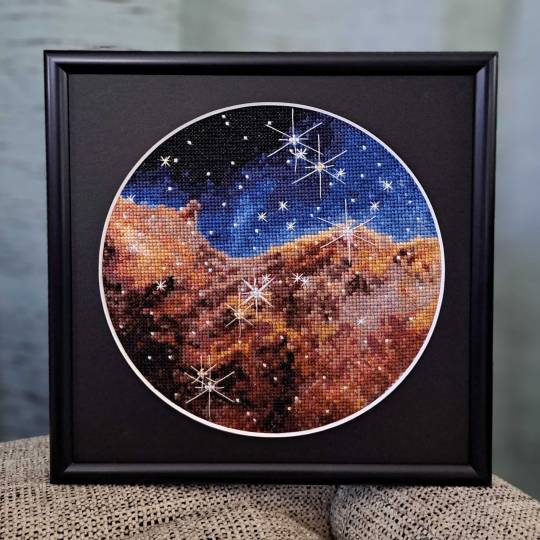
Wendy Edwards, a project coordinator with Earth Science Data Systems at NASA, created this embroidered piece inspired by Webb’s Carina Nebula image. Captured in infrared light, this image revealed for the first time previously invisible areas of star birth. Credit: Wendy Edwards, NASA. Pattern credit: Clare Bray, Climbing Goat Designs
Wendy Edwards, a project coordinator with Earth Science Data Systems at NASA, first learned cross stitch in middle school where she had to pick rotating electives and cross stitch/embroidery was one of the options. “When I look up to the stars and think about how incredibly, incomprehensibly big it is out there in the universe, I’m reminded that the universe isn’t ‘out there’ at all. We’re in it,” she said. Her latest piece focused on Webb’s image release of the Carina Nebula. The image showcased the telescope’s ability to peer through cosmic dust, shedding new light on how stars form.
Ocean Color Imagery: Exploring the North Caspian Sea
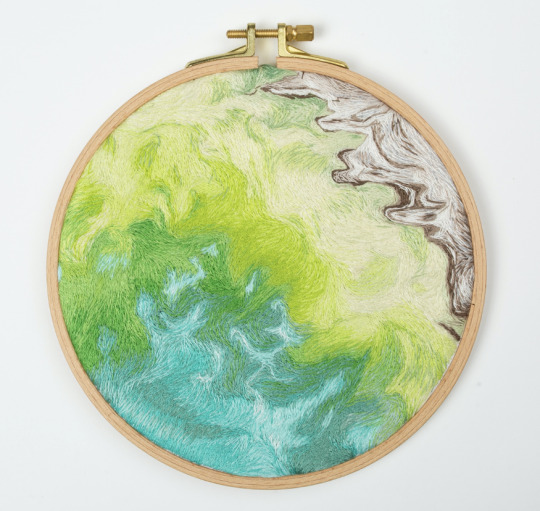
Danielle Currie of Satellite Stitches created a piece inspired by the Caspian Sea, taken by NASA’s ocean color satellites. Credit: Danielle Currie/Satellite Stitches
Danielle Currie is an environmental professional who resides in New Brunswick, Canada. She began embroidering at the beginning of the Covid-19 pandemic as a hobby to take her mind off the stress of the unknown. Danielle’s piece is titled “46.69, 50.43,” named after the coordinates of the area of the northern Caspian Sea captured by LandSat8 in 2019.
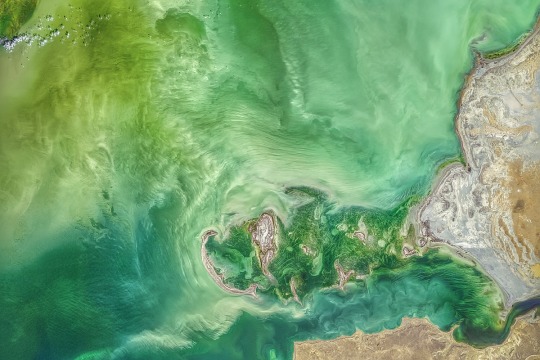
An image of the Caspian Sea captured by Landsat 8 in 2019. Credit: NASA
Two Hubble Images of the Pillars of Creation, 1995 and 2015
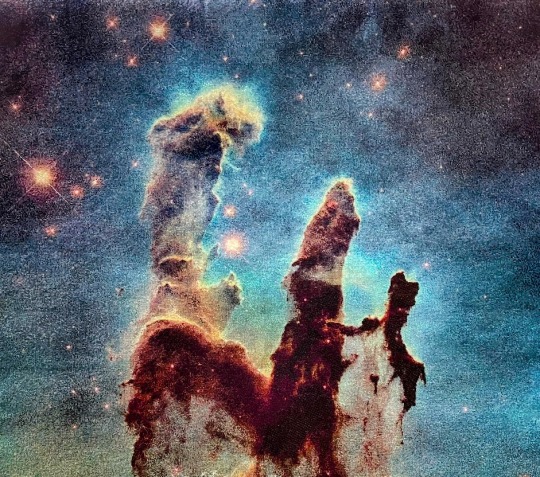
Melissa Cole of Star Stuff Stitching created an embroidery piece based on the Hubble image Pillars of Creation released in 1995. Credit: Melissa Cole, Star Stuff Stitching
Melissa Cole is an award-winning fiber artist from Philadelphia, PA, USA, inspired by the beauty and vastness of the universe. They began creating their own cross stitch patterns at 14, while living with their grandparents in rural Michigan, using colored pencils and graph paper. The Pillars of Creation (Eagle Nebula, M16), released by the Hubble Telescope in 1995 when Melissa was just 11 years old, captured the imagination of a young person in a rural, religious setting, with limited access to science education.
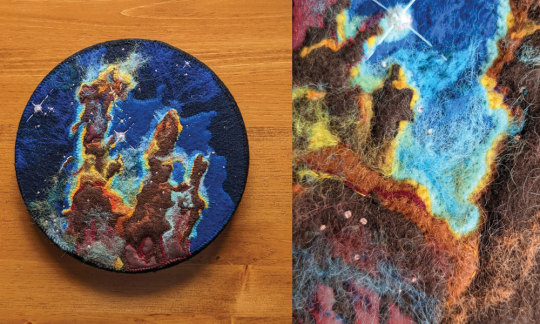
Lauren Wright Vartanian of the shop Neurons and Nebulas created this piece inspired by the Hubble Space Telescope’s 2015 25th anniversary re-capture of the Pillars of Creation. Credit: Lauren Wright Vartanian, Neurons and Nebulas
Lauren Wright Vartanian of Guelph, Ontario Canada considers herself a huge space nerd. She’s a multidisciplinary artist who took up hand sewing after the birth of her daughter. She’s currently working on the illustrations for a science themed alphabet book, made entirely out of textile art. It is being published by Firefly Books and comes out in the fall of 2024. Lauren said she was enamored by the original Pillars image released by Hubble in 1995. When Hubble released a higher resolution capture in 2015, she fell in love even further! This is her tribute to those well-known images.
James Webb Telescope Captures Pillars of Creation
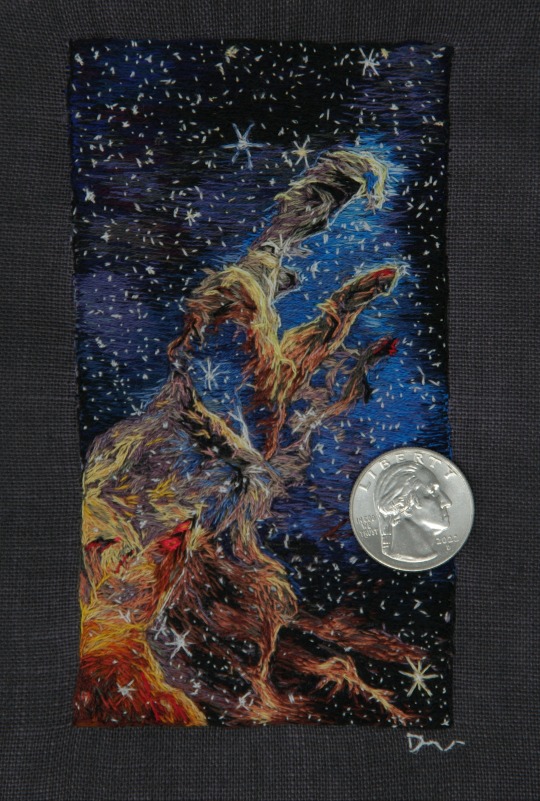
Darci Lenker of Darci Lenker Art, created a rectangular version of Webb’s Pillars of Creation. Credit: Darci Lenker of Darci Lenker Art
Darci Lenker of Norman, Oklahoma started embroidery in college more than 20 years ago, but mainly only used it as an embellishment for her other fiber works. In 2015, she started a daily embroidery project where she planned to do one one-inch circle of embroidery every day for a year. She did a collection of miniature thread painted galaxies and nebulas for Science Museum Oklahoma in 2019. Lenker said she had previously embroidered the Hubble Telescope’s image of Pillars of Creation and was excited to see the new Webb Telescope image of the same thing. Lenker could not wait to stitch the same piece with bolder, more vivid colors.
Milky Way
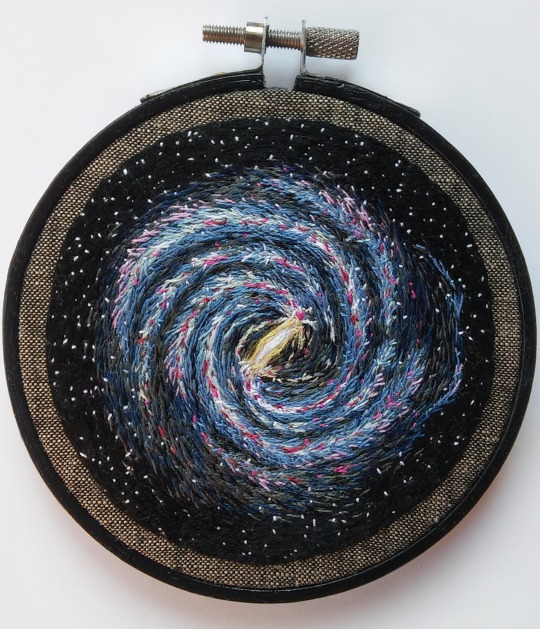
Darci Lenker of Darci Lenker Art was inspired by NASA’s imaging of the Milky Way Galaxy. Credit: Darci Lenker
In this piece, Lenker became inspired by the Milky Way Galaxy, which is organized into spiral arms of giant stars that illuminate interstellar gas and dust. The Sun is in a finger called the Orion Spur.
The Cosmic Microwave Background
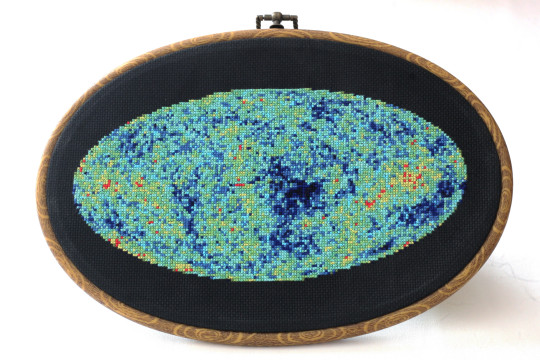
This image shows an embroidery design based on the cosmic microwave background, created by Jessica Campbell, who runs Astrostitches. Inside a tan wooden frame, a colorful oval is stitched onto a black background in shades of blue, green, yellow, and a little bit of red. Credit: Jessica Campbell/ Astrostitches
Jessica Campbell obtained her PhD in astrophysics from the University of Toronto studying interstellar dust and magnetic fields in the Milky Way Galaxy. Jessica promptly taught herself how to cross-stitch in March 2020 and has since enjoyed turning astronomical observations into realistic cross-stitches. Her piece was inspired by the cosmic microwave background, which displays the oldest light in the universe.

The full-sky image of the temperature fluctuations (shown as color differences) in the cosmic microwave background, made from nine years of WMAP observations. These are the seeds of galaxies, from a time when the universe was under 400,000 years old. Credit: NASA/WMAP Science Team
GISSTEMP: NASA’s Yearly Temperature Release
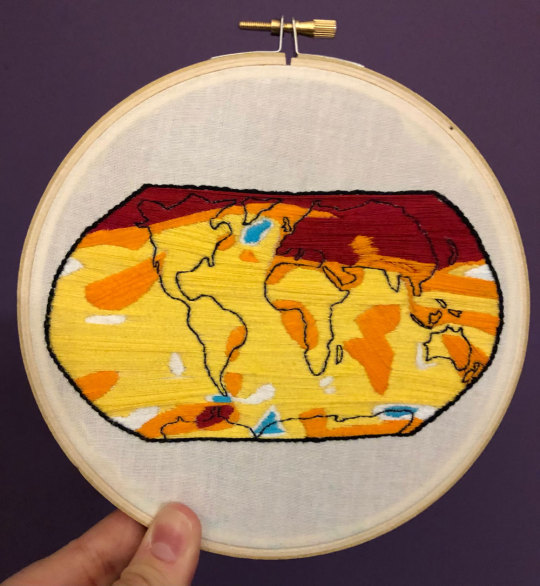
Katy Mersmann, a NASA social media specialist, created this embroidered piece based on NASA’s Goddard Institute for Space Studies (GISS) global annual temperature record. Earth’s average surface temperature in 2020 tied with 2016 as the warmest year on record. Credit: Katy Mersmann, NASA
Katy Mersmann is a social media specialist at NASA’s Goddard Space Flight Center in Greenbelt, Md. She started embroidering when she was in graduate school. Many of her pieces are inspired by her work as a communicator. With climate data in particular, she was inspired by the researchers who are doing the work to understand how the planet is changing. The GISTEMP piece above is based on a data visualization of 2020 global temperature anomalies, still currently tied for the warmest year on record.
In addition to embroidery, NASA continues to inspire art in all forms. Check out other creative takes with Landsat Crafts and the James Webb Space telescope public art gallery.
Make sure to follow us on Tumblr for your regular dose of space!
#NASA#creativity#fiber art#embroidery#art#art challenge#needlework#crafts#handmade#textile art#cross stitch#stitching#inspiration#inspo#Earth#Earth science#Hubble#James Webb Space Telescope#climate change#water#nebula#stars
6K notes
·
View notes
Text
This is extremely cool. A lot of urban and suburban properties that could otherwise grow food have problems with contaminated soils, mine included.
Of course now I'm wondering if it would be safe to grow cotton, flax, or other fibre plants in contaminated soils. Would the lead transfer to the cotton boll or the bast (probably in the case of the bast, I have no idea on the cotton)? And would the fibre still be usable in such a state?
Or dye plants. What's the deal with dye plants? You gotta boil them suckers to turn them into dye liquor, so I'm guessing it would Not Be A Good Idea to grow them on contaminated soil, but I would *love* to find out if anyone has done any research into this.


As a community scientist with Prospering Backyards, my science team is monitoring a lead contaminated yard at a house in south central. We are working on extracting lead out of certain areas using zeolites. Each month we take soil samples to the main scientists at the Natural History Museum. They are diligently working in the lab on community solutions. You cannot grow nutrient food in contaminated soil.
55 notes
·
View notes
Note
Who won teacher of the year?
If we are talking about LMK Highschool Teacher AU?

Mr Sun (Wukong). By a long shot. He wins the hypothetical award every year. Macaque of course always comes bitter second.
And now I'll use this ask as an excuse to introduce two more teachers to the AU





Continuation from here:
#lego monkie kid#lego monkie kid fanart#monkie kid#monkie kid fanart#lmk#lmk fanart#lmk sun sukong#monkie king sun wukong#lmk macaque#monkie kid macaque#lmk spider queen#monkie kid spider queen#lmk syntax#monkie kid syntax#LMK Highschool Teacher AU#originally Syntax was going to be the physics teacher but I changed my mind#he's probably qualified to teach any science subject though- actually out of all the teachers he has the most widest range of classes#like he is everywhere in the science and technology department#Textiles teachers always have a certain vibe to them and I'm sure Ms Queenie can reflect it. Somehow#I don't know what I'm going to do about Huntsman and Goliath- I can't see them working at the school
89 notes
·
View notes
Text
The practice of purposely looping thread to create intricate knit garments and blankets has existed for millennia. Though its precise origins have been lost to history, artifacts like a pair of wool socks from ancient Egypt suggest it dates back as early as the 3rd to 5th century CE. Yet, for all its long-standing ubiquity, the physics behind knitting remains surprisingly elusive. "Knitting is one of those weird, seemingly simple but deceptively complex things we take for granted," says theoretical physicist and visiting scholar at the University of Pennsylvania, Lauren Niu, who recently took up the craft as a means to study how "geometry influences the mechanical properties and behavior of materials." Despite centuries of accumulated knowledge, predicting how a particular knit pattern will behave remains difficult -- even with modern digital tools and automated knitting machines. "It's been around for so long, but we don't really know how it works," Niu notes. "We rely on intuition and trial and error, but translating that into precise, predictive science is a challenge."
Read more.
60 notes
·
View notes
Text
I’m three years into a fashion merchandising degree and only now am I finding out that germ theory of disease came from a guy trying to save his silkworms.
#three years of textile science classes and I had to learn this from a personal book outside of school#ramblin’ woman
14 notes
·
View notes
Text


i did Not cry in the museum but it was a very near thing
#yeehawing; gunshots#i don’t have a terrific opinion of the houston museum of science#exhibits mostly focused on short form video and bad minigames#scanty on the interpretation and provenance#and all of their mummies were partially unwrapped which i do not like!!!! why do you have those in the first place!!!#but by god did they have some old linen#textile crimes
47 notes
·
View notes
Text





𝐔𝐧𝐥𝐨𝐜𝐤 𝐭𝐡𝐞 𝐒𝐞𝐜𝐫𝐞𝐭𝐬 𝐁𝐞𝐡𝐢𝐧𝐝 𝐋𝐮𝐱𝐮𝐫𝐢𝐨𝐮𝐬 𝐅𝐚𝐛𝐫��𝐜𝐬: 𝐃𝐢𝐯𝐞 𝐢𝐧𝐭𝐨 𝐅𝐚𝐛𝐫𝐢𝐜 𝐅𝐢𝐧𝐢𝐬𝐡𝐢𝐧𝐠 𝐓𝐞𝐜𝐡𝐧𝐢𝐪𝐮𝐞𝐬
Discover how fabric finishing transforms raw textiles into luxurious materials. Explore essential techniques like scouring, bleaching, and mercerizing that enhance texture, appearance, and performance. Learn about mechanical processes such as calendering and raising, and chemical treatments that impart wrinkle resistance and water repellency. This comprehensive guide offers insights into the art and science behind the fabrics we use daily, making it indispensable for textile enthusiasts and professionals alike.
Regards, Fashion Articles by Waves Fashion Institute
#fabric#fabric processing#textile#textile industry#fabric care#textile innovation#textile technology#textile manufacturing#fabric finishing#fashion#fashion design#textile science#fabric science#dyeing#printing#painting#cleaning
0 notes
Text
Higher thread counts are seen as desirable because they make materials softer, and tend to wear better over time – the more strands there are to begin with, the more there will remain to hold the fabric together when some begin to fray.
Zaria Gorvett, The ancient fabric that no one knows how to make
#weaving#textiles#fiber arts#fiber science#zaria gorvett#gorvett#the ancient fabric that no one knows how to make#2021#gorvett 2021#3/16/2021
24 notes
·
View notes
Text
Dyes widely used in the textile, food and pharmaceutical industries pose a pressing threat to plant, animal and human health, as well as natural environments around the world, a new study has found. Billions of tons of dye-containing wastewater enter water systems every year, and a group of researchers from the UK, China, Korea and Belgium say that new sustainable technologies including new membrane-based nano-scale filtration are needed to solve the issue, adding that legislation is needed to compel industrial producers to eliminate colorants before they reach public sewage systems or waterways. Published today in Nature Reviews Earth & Environment, the study Environmental impacts and remediation of dye-containing wastewater was written by academics from the University of Bath, the Chinese Academy of Sciences, the Fujian Agriculture and Forestry University, the Korea Institute of Energy Technology (KENTECH), and KU Leuven, Belgium. The research highlights that currently, up to 80% of dye-containing industrial wastewaters created in low- and middle-income countries are released untreated into waterways or used directly for irrigation. The authors say this poses a wide range of direct and indirect threats to human, animal and plant health
Continue Reading
123 notes
·
View notes